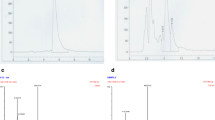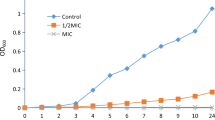Abstract
Natural products have been developed as an alternative source of novel antibacterials in combating food-borne pathogens such as Staphylococcus aureus (S. aureus), Salmonella, Listeria monocytogenes. The aims of this study were to investigate the antimicrobial effect of chlorogenic acid (CA) on S. aureus and to elucidate its mechanism of action. Minimum inhibitory concentrations of CA were determined using the agar dilution method. Intracellular pH (pHin), membrane potential, intracellular and extracellular ATP concentrations, and the release of cell constituents were measured to elucidate antibacterial mechanism. Morphological changes induced by CA were examined by electron microscopy. CA induced a decrease in the intracellular ATP concentrations, but no proportional increase in the extracellular ATP. And the release of cell constituents increased significantly when treated with CA. A reduction in pHin and cell membrane hyperpolarization were observed in S. aureus after CA treatment. Electron microscopic observations showed that the cell membrane of S. aureus was damaged by CA. It is concluded that CA inhibited the proliferation of S. aureus and destroyed the permeability of the cell membrane. The findings indicated that CA has the potential to be developed as an alternative to control S. aureus and the diseases associated with this microorganism.






Similar content being viewed by others
References
Qiu J, Wang D, Xiang H, Feng H, Jiang Y, Xia L, Dong J, Lu J, Yu L, Deng X (2010) Subinhibitory concentrations of thymol reduce enterotoxins A and B and α-hemolysin production in Staphylococcus aureus isolates. PLoS ONE 5(3):e9736
Redelman CV, Maduakolam C, Anderson GG (2012) Alcohol treatment enhances Staphylococcus aureus biofilm development. FEMS Immunol Med Microbiol 66(3):411–418
Kurlenda J, Grinholc M (2012) Alternative therapies in Staphylococcus aureus diseases. Acta Biochim Pol 59(2):171–184
Hennekinne J-A, De Buyser M-L, Dragacci S (2012) Staphylococcus aureus and its food poisoning toxins: characterization and outbreak investigation. FEMS Microbiol Rev 36(4):815–836
Smith J, Buchanan R, Palumbo S (1983) Effect of food environment on Staphylococcal enterotoxin synthesis: a review. J Food Prot 46:545–555
Al-Zoreky N (2009) Antimicrobial activity of pomegranate (Punica granatum L.) fruit peels. Int J Food Microbiol 134(3):244–248
Carson C, Hammer K, Riley T (2006) Melaleuca alternifolia (tea tree) oil: a review of antimicrobial and other medicinal properties. Clin Microbiol Rev 19(1):50–62
Ankri S, Mirelman D (1999) Antimicrobial properties of allicin from garlic. Microbes Infect 1(2):125–129
Gyawali R, Ibrahim SA (2012) Impact of plant derivatives on the growth of foodborne pathogens and the functionality of probiotics. Appl Microbiol Biotechnol 95(1):29–45
Farah A, de Paulis T, Trugo LC, Martin PR (2005) Effect of roasting on the formation of chlorogenic acid lactones in coffee. J Agric Food Chem 53(5):1505–1513
Li S-Y, Chang C-Q, Ma F-Y, Yu C-L (2009) Modulating effects of chlorogenic acid on lipids and glucose metabolism and expression of hepatic peroxisome proliferator-activated receptor-α in golden hamsters fed on high fat diet. Biomed Environ Sci 22(2):122–129
Wang G-F, Shi L-P, Ren Y-D, Liu Q-F, Liu H-F, Zhang R-J, Li Z, Zhu F-H, He P-L, Tang W (2009) Anti-hepatitis B virus activity of chlorogenic acid, quinic acid and caffeic acid in vivo and in vitro. Antivir Res 83(2):186–190
Lou Z, Wang H, Zhu S, Ma C, Wang Z (2011) Antibacterial activity and mechanism of action of chlorogenic acid. J Food Sci 76(6):M398–M403
Sung WS, Lee DG (2010) Antifungal action of chlorogenic acid against pathogenic fungi, mediated by membrane disruption. Pure Appl Chem 82(1):219–226
EUCAST (2010) Determination of minimum inhibitory concentration (MICs) of antibacterial agents by agar dilution. Clin Microbiol Infect 6:509–515
Qiu J, Feng H, Xiang H, Wang D, Xia L, Jiang Y, Song K, Lu J, Yu L, Deng X (2010) Influence of subinhibitory concentrations of licochalcone A on the secretion of enterotoxins A and B by Staphylococcus aureus. FEMS Microbiol Lett 307(2):135–141
Rhayour K, Bouchikhi T, Tantaoui-Elaraki A, Sendide K, Remmal A (2003) The mechanism of bactericidal action of oregano and clove essential oils and of their phenolic major components on Escherichia coli and Bacillus subtilis. J Essent Oil Res 15(4):286–292
Turgis M, Han J, Caillet S, Lacroix M (2009) Antimicrobial activity of mustard essential oil against Escherichia coli O157: H7 and Salmonella typhi. Food Control 20(12):1073–1079
Breeuwer P, Drocourt J, Rombouts FM, Abee T (1996) A novel method for continuous determination of the intracellular pH in bacteria with the internally conjugated fluorescent probe 5 (and 6-)-carboxyfluorescein succinimidyl ester. Appl Environ Microbiol 62(1):178–183
Sánchez E, García S, Heredia N (2010) Extracts of edible and medicinal plants damage membranes of Vibrio cholerae. Appl Environ Microbiol 76(20):6888–6894
Lv F, Liang H, Yuan Q, Li C (2011) In vitro antimicrobial effects and mechanism of action of selected plant essential oil combinations against four food-related microorganisms. Food Res Int 44(9):3057–3064
Yao X, Zhu X, Pan S, Fang Y, Jiang F, Phillips GO, Xu X (2012) Antimicrobial activity of nobiletin and tangeretin against Pseudomonas. Food Chem 132(4):1883–1890
Lambert R, Skandamis PN, Coote PJ, Nychas GJ (2001) A study of the minimum inhibitory concentration and mode of action of oregano essential oil, thymol and carvacrol. J Appl Microbiol 91(3):453–462
Ultee A, Kets E, Smid E (1999) Mechanisms of action of carvacrol on the food-borne pathogen Bacillus cereus. Appl Environ Microbiol 65(10):4606–4610
Lee J-Y, Kim Y-S, Shin D-H (2002) Antimicrobial synergistic effect of linolenic acid and monoglyceride against Bacillus cereus and Staphylococcus aureus. J Agric Food Chem 50(7):2193–2199
Biteau B, Labarre J, Toledano MB (2003) ATP-dependent reduction of cysteine–sulphinic acid by S. cerevisiae sulphiredoxin. Nature 425(6961):980–984
Yuroff A, Sabat G, Hickey W (2003) Transporter-mediated uptake of 2-chloro-and 2-hydroxybenzoate by Pseudomonas huttiensis strain D1. Appl Environ Microbiol 69(12):7401–7408
Bot C, Prodan C (2009) Probing the membrane potential of living cells by dielectric spectroscopy. Eur Biophys J 38(8):1049–1059
Acknowledgments
This work was supported by the International Science and Technology Collaboration Research Fund (No. A213021202) in Northwest A&F University.
Conflict of interest
None.
Compliance with Ethics Requirements
This article does not contain any studies with human or animal subjects.
Author information
Authors and Affiliations
Corresponding author
Rights and permissions
About this article
Cite this article
Li, G., Wang, X., Xu, Y. et al. Antimicrobial effect and mode of action of chlorogenic acid on Staphylococcus aureus . Eur Food Res Technol 238, 589–596 (2014). https://doi.org/10.1007/s00217-013-2140-5
Received:
Revised:
Accepted:
Published:
Issue Date:
DOI: https://doi.org/10.1007/s00217-013-2140-5




